
Manufacturers of fire equipment, from those making nozzles and monitors to fire pumps and self-contained breathing apparatus (SCBA), are incorporating more technology into their products than ever before. Manufacturers explain how technology makes their products more reliable and easier to use for firefighters.
Task Force Tips
Task Force Tips (TFT) has used technology to develop a grouping of products that are related to flow and pressure measurements in hose handlines. “The challenge for years is knowing what you’re actually flowing,” says Phil Gerace, TFT’s director of marketing. “Firefighters have used pocket cards that had formulas to calculate friction loss in hoses and nozzles, but those old measurements are less accurate as to what’s really going on.”

1 Task Force Tips makes the SHO-FLOW™ flow meter that functions through a Bluetooth® connection to help firefighters determine the actual flow at the nozzle. (Photos 1-2 courtesy of Task Force Tips.)
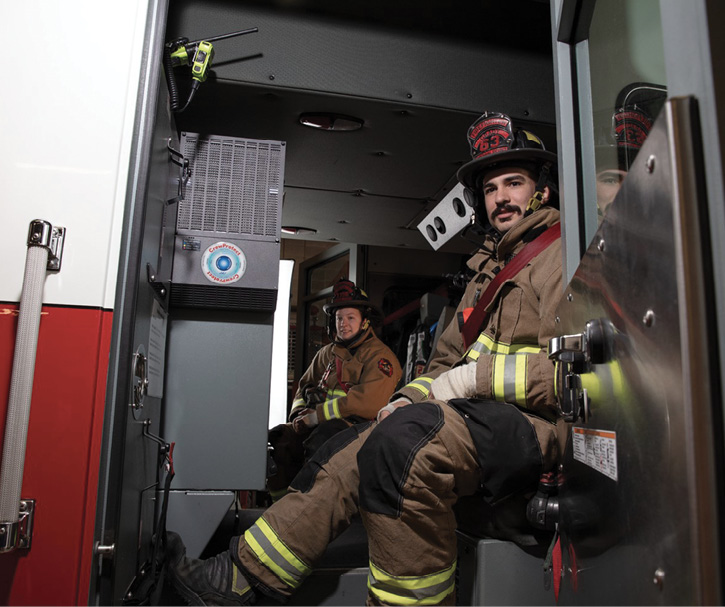
2 TFT’s CrewProtect™ air decontamination and filter system was developed specifically for fire apparatus.
Gerace continues, “So TFT introduced the Bluetooth flow meter and flow gauge, SHO-FLOW® and SHO-GAUGE®, to help firefighters understand what’s actually flowing at the nozzle; to set up pump discharge pressures; to measure nozzle reaction; and, by using hose and nozzle data, to reflect real-time flows and pressures. They also can be used in testing, truck setup, and training scenarios. SHO-FLOW has versions that work with 1-inch handlines up to monitors.”
TFT also has used technology in its CrewProtect™ air decontamination and filter system. “CrewProtect is developed specifically for fire apparatus,” Gerace observes. “It uses integrated cartridge technology proven by NASA, Intel, and hospitals and laboratories around the country. CrewProtect, which comes in sizes for full-sized fire apparatus as well as wildland rigs, chief’s vehicles, and ambulances, traps and neutralizes particulates, volatile organic compounds, and aerosols and turns them into something that is not harmful. The cartridge should be changed twice a year and can be disposed of in the trash because it is nonhazardous material. CrewProtect can be installed new or retrofitted to existing fire vehicles.”
3M™ Scott™ Fire & Safety
3M Scott Fire & Safety has used technology to develop its telemetry system for its series of 3M™ Scott™ Air-Pak™ SCBA, taking advantage of a wireless mesh network that sends information to an incident commander (IC) about SCBA status, how much air pressure is left, if it is in low-air alarm, if the firefighter has stopped moving through its integration with the PASS alarm, and whether air is flowing. The system also allows an IC to issue a Personal Accountability Report (PAR) without doing so over radio traffic.
Technology also allowed 3M Scott to develop Sight, an in-mask thermal imaging solution. Longin Kloc, 3M Scott’s new product marketer for SCBA and fire, says the thermal imaging camera module is mounted on the right side of the face piece, which the firefighter can activate using a single button. “It connects easily to the face piece and streams the thermal image into the face piece in-mask display located beside the nose cup via Bluetooth®,” Kloc says. “The display is clear and allows for hands-free operation. 3M Scott Sight also has the potential to be used for navigation.”
Kloc says 3M Scott also is taking SCBA telemetry data and making it available through an application programming interface (API) to incident management companies, to allow them to integrate the information with their management technology solutions to give the fire service a more holistic view of an incident.
Safe Fleet
Mike Dupay, divisional vice president of marketing for fire, EMS and industrial at Safe Fleet, says his company views the use of technology as to how it can make its products more intuitive, easier to use, and safer. Dupay pointed to Elkhart Brass Company’s line of EXM2 monitors that use an integrated Wi-Fi system and web browser to allow a firefighter to set up the monitor, manage presets, and control the system. These monitors include the Cobra EXM2, Sidewinder EXM2, and Sidewinder UHP EXM2. “We used computational fluid dynamics modeling software to model the flow through the monitors and adjusted the parameters for the minimal amount of friction loss,” he says.

3 Safe Fleet’s Elkhart Brass Company makes the APEX electronic valve controllers that incorporate a flow meter, pressure gauge, and valve position displays. (Photos 3-4 courtesy of Safe Fleet.)
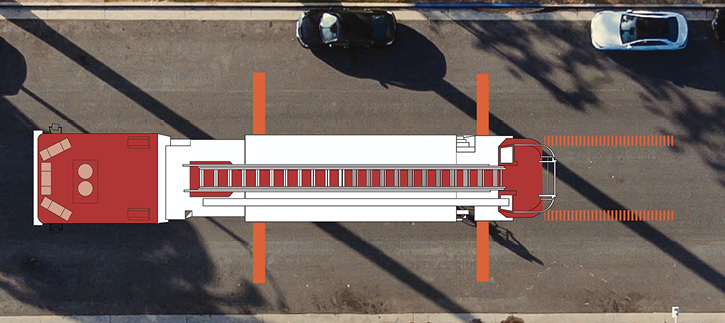
4 Safe Fleet’s FRC division makes the inView 360 HD high-definition camera that can be used when parking a vehicle to see the area where outriggers or portable water tanks will be placed to keep clear of obstructions.
Pete Luhrs, vice president of product management for Safe Fleet, says technology is behind Elkhart Brass’s APEX electronic valve controllers. “We wanted to give firefighters more settings for presets in both our pressure only and our pressure and flow models,” Luhrs points out. “The flow meter display shows a valve position bar graph, a pressure gauge message display, and a valve closed indicator and has an optional sun visor and a customizable color strip to match the discharge and hose color.”
Luhrs says Safe Fleet’s FRC division uses technology in its inView 360 HD high-definition camera that has three functions when an apparatus is operating: safety while driving, turn signal on or off left/right for collision avoidance, and when parking an overlay for aerial outriggers or portable water tanks to see the area where they will be placed to keep clear of obstructions.
MSA Safety
Matthew Quigley, product platform manager for the connected firefighter at MSA Safety, says the cornerstone of MSA’s technology-laden products is the G1 SCBA platform. “With G1’s connectivity, we’ve digitized analog procedures of incident command, inventory, and data analytics and expanded it through our LUNAR and FireGrid platforms to add more safety and functionality to our products,” Quigley points out.
Quigley notes the G1 has a central power system for all electronics; incorporates Bluetooth, RFID, Near Field Communication, and long-range radio technologies; and, through a partnership with Fotokite, can access aerial video from a tethered drone.
MSA’s LUNAR product is a handheld wireless device that can keep firefighters connected through MSA’s FireGrid cloud computing system and is equipped with Firefighting Assisting Search Technology, edge detection enhanced thermal imaging, and connectivity. It also can be paired with MSA’s Altair 4XR and 5X gas detectors.
HURST Jaws of Life®
Michael Canon, director of rescue sales for HURST Jaws of Life®, says that technology has improved the cutting and spreading force, power at the tip, and battery run time of its hydraulic rescue tools. “With our eDRAULIC generation of hydraulic rescue tools, the circuit board and battery can give the firefighter real-time information about the tool’s capabilities. A lithium-ion battery connects to the circuit board, which connects to the motor and control valve of the unit,” Canon notes. “We’ve put more computing capability on the tool because battery power has increased, so the firefighter needs only to glance down at the dashboard between his hands to get real-time information.”
That information includes both battery and pump status, Canon adds, with battery status shown in 25% increments. The state of the pump will either register as first stage, where the tool moves faster but not with a lot of force, or second stage, which has a higher pressure but lower volume so that the tool slows down a bit, Canon says. That information shows the firefighter that the tool is not bogging down but is building second stage pressure, so the data can prevent the firefighter from backing out or repositioning the tool prematurely.
“Cutter roll is an issue with cutting tools because new cars have such hard-to-defeat posts. New cars require such powerful cutters that they are strong enough to break their own blades if improperly cut,” Canon says. “An unbreakable blade is an impractical solution because it would be too thick and heavy, so our cutter technology has a spatial recognition and an eye on the amperage draw on the pump. When the cutter is in second stage and the axial rotation exceeds 15 degrees, the firefighter gets a red-light warning around the power light that if he doesn’t do something, there’s a likely risk of breaking the cutter if the cut continues in the same manner. This allows a back-off and recut.”
IDEX Fire & Safety
Sarah Hay, business optimization director for IDEX Fire & Safety, says technology powers IDEX’s E3 Connect and Captium system platforms to provide early fault detection and reduce downtime on Hurst Jaws of Life hydraulic tools. “It’s a cloud product where the user logs into the Captium Web site and manages all of their registered extrication tools,” Hay says. “The user can look for alerts on various tools and use telemetry to provide troubleshooting when something shows up that needs to be addressed.”
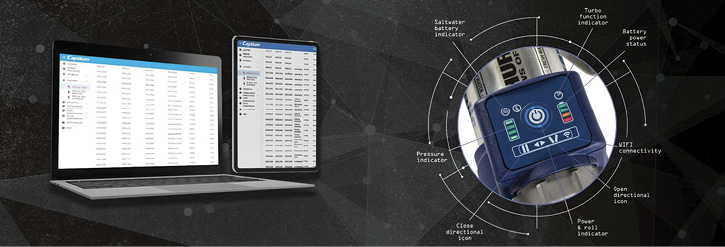
5 IDEX Fire & Safety’s Captium system uses technology to connect with HURST Jaws of Life eDraulic hydraulic tools to provide tool data and early fault detection. (Photos 5-6 courtesy of IDEX Fire & Safety.)
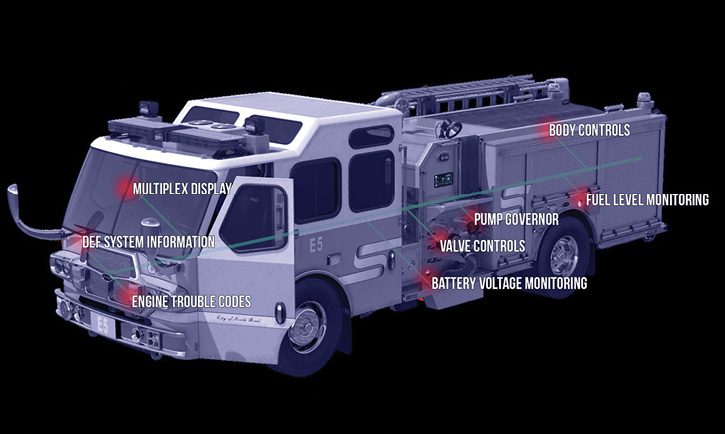
6 The IDEX Captium system also can connect to a fire vehicle’s data.

7 MSA Safety’s G1 SCBA platform incorporates Bluetooth, RFID, Near Field Communication, and long-range radio technologies. (Photos 7-8 courtesy of MSA Safety.)
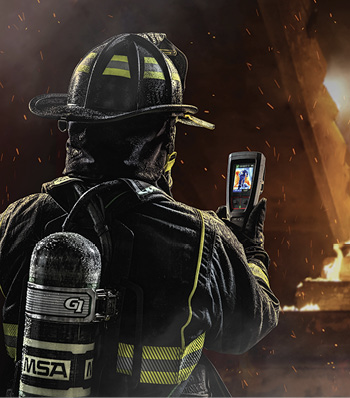
8 MSA Safety’s LUNAR product is a hand-held wireless device that keeps firefighters connected through MSA’s FireGrid cloud computing system.
Steve Rowland, product manager of multiplexing for IDEX, points out that the Captium system also can connect to a fire vehicle’s data. “It has a connection with Cummins where it gets data from them regarding any potential engine issues,” Rowland says, “and can put a fleet manager in the vehicle at all times, either through the fire department or through their dealer.”
ALAN M. PETRILLO is a Tucson, Arizona-based journalist, the author of three novels and five nonfiction books, and a member of the Fire Apparatus & Emergency Equipment Editorial Advisory Board. He served 22 years with the Verdoy (NY) Fire Department, including in the position of chief.

